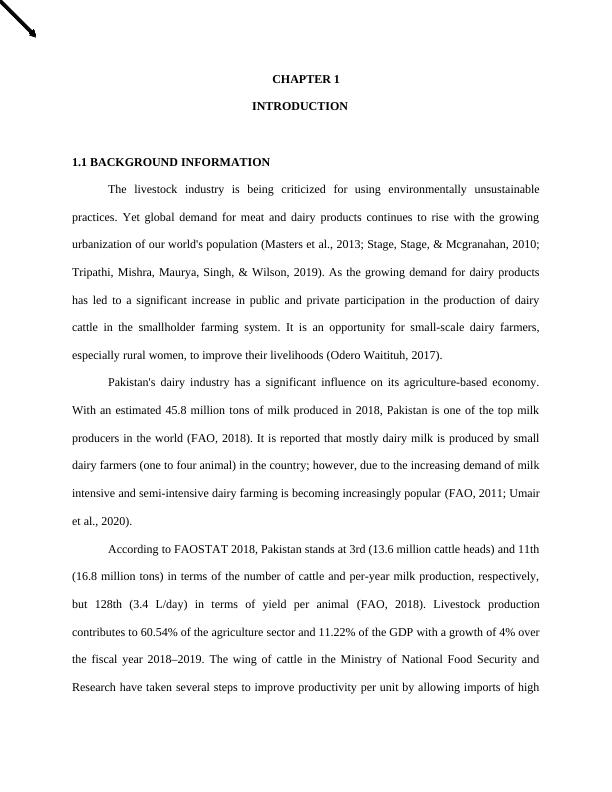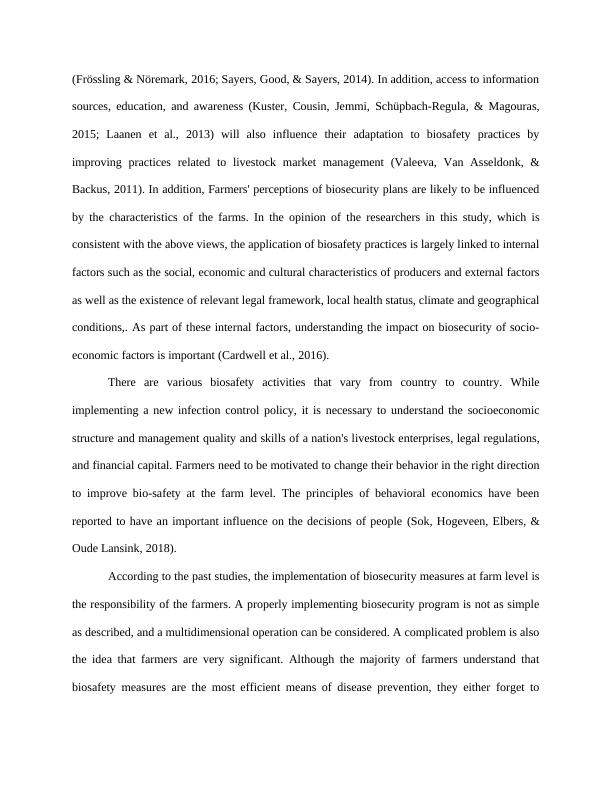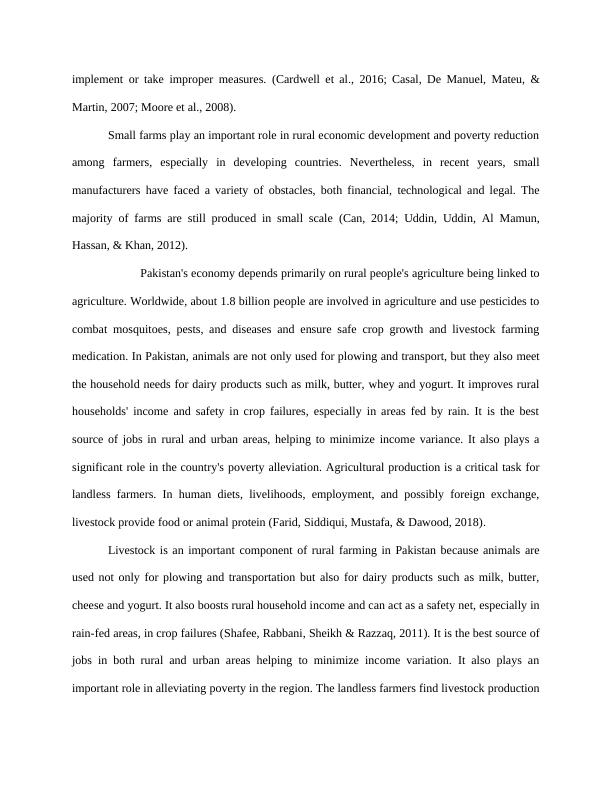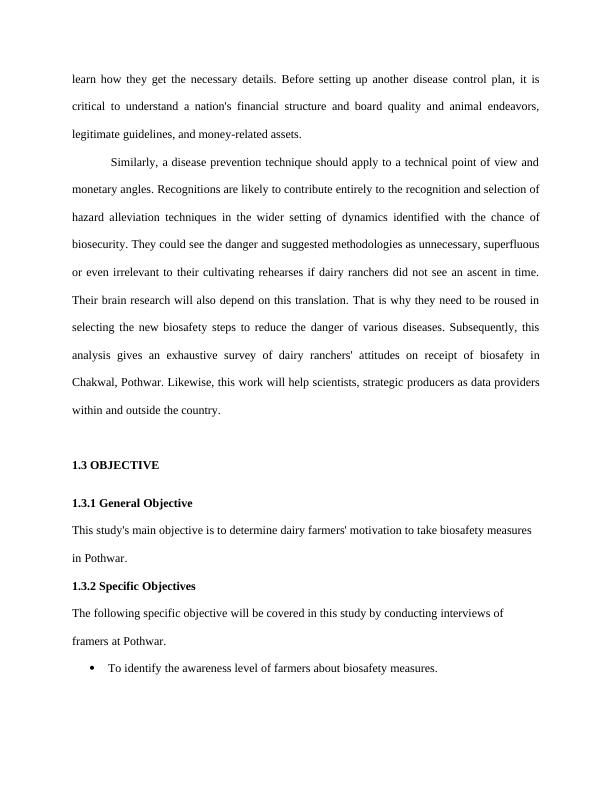livestock industry Assignment PDF
24 Pages7159 Words137 Views
Added on 2021-08-19
livestock industry Assignment PDF
Added on 2021-08-19
ShareRelated Documents
CHAPTER 1
INTRODUCTION
1.1 BACKGROUND INFORMATION
The livestock industry is being criticized for using environmentally unsustainable
practices. Yet global demand for meat and dairy products continues to rise with the growing
urbanization of our world's population (Masters et al., 2013; Stage, Stage, & Mcgranahan, 2010;
Tripathi, Mishra, Maurya, Singh, & Wilson, 2019). As the growing demand for dairy products
has led to a significant increase in public and private participation in the production of dairy
cattle in the smallholder farming system. It is an opportunity for small-scale dairy farmers,
especially rural women, to improve their livelihoods (Odero Waitituh, 2017).
Pakistan's dairy industry has a significant influence on its agriculture-based economy.
With an estimated 45.8 million tons of milk produced in 2018, Pakistan is one of the top milk
producers in the world (FAO, 2018). It is reported that mostly dairy milk is produced by small
dairy farmers (one to four animal) in the country; however, due to the increasing demand of milk
intensive and semi-intensive dairy farming is becoming increasingly popular (FAO, 2011; Umair
et al., 2020).
According to FAOSTAT 2018, Pakistan stands at 3rd (13.6 million cattle heads) and 11th
(16.8 million tons) in terms of the number of cattle and per-year milk production, respectively,
but 128th (3.4 L/day) in terms of yield per animal (FAO, 2018). Livestock production
contributes to 60.54% of the agriculture sector and 11.22% of the GDP with a growth of 4% over
the fiscal year 2018–2019. The wing of cattle in the Ministry of National Food Security and
Research have taken several steps to improve productivity per unit by allowing imports of high
INTRODUCTION
1.1 BACKGROUND INFORMATION
The livestock industry is being criticized for using environmentally unsustainable
practices. Yet global demand for meat and dairy products continues to rise with the growing
urbanization of our world's population (Masters et al., 2013; Stage, Stage, & Mcgranahan, 2010;
Tripathi, Mishra, Maurya, Singh, & Wilson, 2019). As the growing demand for dairy products
has led to a significant increase in public and private participation in the production of dairy
cattle in the smallholder farming system. It is an opportunity for small-scale dairy farmers,
especially rural women, to improve their livelihoods (Odero Waitituh, 2017).
Pakistan's dairy industry has a significant influence on its agriculture-based economy.
With an estimated 45.8 million tons of milk produced in 2018, Pakistan is one of the top milk
producers in the world (FAO, 2018). It is reported that mostly dairy milk is produced by small
dairy farmers (one to four animal) in the country; however, due to the increasing demand of milk
intensive and semi-intensive dairy farming is becoming increasingly popular (FAO, 2011; Umair
et al., 2020).
According to FAOSTAT 2018, Pakistan stands at 3rd (13.6 million cattle heads) and 11th
(16.8 million tons) in terms of the number of cattle and per-year milk production, respectively,
but 128th (3.4 L/day) in terms of yield per animal (FAO, 2018). Livestock production
contributes to 60.54% of the agriculture sector and 11.22% of the GDP with a growth of 4% over
the fiscal year 2018–2019. The wing of cattle in the Ministry of National Food Security and
Research have taken several steps to improve productivity per unit by allowing imports of high

yield exotic dairy races (Holstein-Friesian, Jersey), their genetic material (embryos and semen),
feed and agricultural equipment at low import duties. Action is being taken in order to increase
productivity per unit. Dairy production in Pakistan can be classified into five major systems, i.e.,
smallholder subsistence and market-oriented production system, commercial and corporate
sector systems, and peri-urban and urban-centred systems. The corporate sector accounts for
<1% of the dairy sector in the country and maintains highly produced exotic cattle breeds with an
average herd size of 2,000-5,000 animals (Holstein-Friesian and Jersey). At present, only 15 of
the largest companies in the country operate (Redding, Bender, & Baker, 2019).
Biosecurity is defined as a set of management procedures that prevent the risk of
introducing new diseases to a farm and to minimize or to eliminate the spread of disease within
the herd (Fasina, Lazarus, Spencer, Makinde, & Bastos, 2012; Moore, Merryman, Hartman, &
Klingborg, 2008). Biosecurity is described as a group of management procedures that avoid the
risk of new diseases being introduced to a farm and minimize or eliminate the spread of disease
within the dairy farm. (Oliveira, Sørensen, & Thomsen, 2017; Postma et al., 2016).
Biosecurity measures in dairy farms are rarely implemented (Renault et al., 2018;
Sarrazin, Cay, Laureyns, & Dewulf, 2014). In various studies, several psychosocial factors in
dairy farmers and veterinarians have been identified that could influence their decision on
whether or not to implement biosecurity measures. Among these factors, the attitude of farmers
and veterinarians towards implementing biosecurity measures could be influenced by the
technical knowledge they have (Frössling & Nöremark, 2016; Toma, Stott, Heffernan, Ringrose
& Gunn, 2013), the individual experiences they have experienced (Broughan et al., 2016), the
importance they can attribute to risks and the benefits they can have (Ciaravino et al., 2017).
Their behavior may be affected by factors such as age and gender or location and size of the farm
feed and agricultural equipment at low import duties. Action is being taken in order to increase
productivity per unit. Dairy production in Pakistan can be classified into five major systems, i.e.,
smallholder subsistence and market-oriented production system, commercial and corporate
sector systems, and peri-urban and urban-centred systems. The corporate sector accounts for
<1% of the dairy sector in the country and maintains highly produced exotic cattle breeds with an
average herd size of 2,000-5,000 animals (Holstein-Friesian and Jersey). At present, only 15 of
the largest companies in the country operate (Redding, Bender, & Baker, 2019).
Biosecurity is defined as a set of management procedures that prevent the risk of
introducing new diseases to a farm and to minimize or to eliminate the spread of disease within
the herd (Fasina, Lazarus, Spencer, Makinde, & Bastos, 2012; Moore, Merryman, Hartman, &
Klingborg, 2008). Biosecurity is described as a group of management procedures that avoid the
risk of new diseases being introduced to a farm and minimize or eliminate the spread of disease
within the dairy farm. (Oliveira, Sørensen, & Thomsen, 2017; Postma et al., 2016).
Biosecurity measures in dairy farms are rarely implemented (Renault et al., 2018;
Sarrazin, Cay, Laureyns, & Dewulf, 2014). In various studies, several psychosocial factors in
dairy farmers and veterinarians have been identified that could influence their decision on
whether or not to implement biosecurity measures. Among these factors, the attitude of farmers
and veterinarians towards implementing biosecurity measures could be influenced by the
technical knowledge they have (Frössling & Nöremark, 2016; Toma, Stott, Heffernan, Ringrose
& Gunn, 2013), the individual experiences they have experienced (Broughan et al., 2016), the
importance they can attribute to risks and the benefits they can have (Ciaravino et al., 2017).
Their behavior may be affected by factors such as age and gender or location and size of the farm

(Frössling & Nöremark, 2016; Sayers, Good, & Sayers, 2014). In addition, access to information
sources, education, and awareness (Kuster, Cousin, Jemmi, Schüpbach-Regula, & Magouras,
2015; Laanen et al., 2013) will also influence their adaptation to biosafety practices by
improving practices related to livestock market management (Valeeva, Van Asseldonk, &
Backus, 2011). In addition, Farmers' perceptions of biosecurity plans are likely to be influenced
by the characteristics of the farms. In the opinion of the researchers in this study, which is
consistent with the above views, the application of biosafety practices is largely linked to internal
factors such as the social, economic and cultural characteristics of producers and external factors
as well as the existence of relevant legal framework, local health status, climate and geographical
conditions,. As part of these internal factors, understanding the impact on biosecurity of socio-
economic factors is important (Cardwell et al., 2016).
There are various biosafety activities that vary from country to country. While
implementing a new infection control policy, it is necessary to understand the socioeconomic
structure and management quality and skills of a nation's livestock enterprises, legal regulations,
and financial capital. Farmers need to be motivated to change their behavior in the right direction
to improve bio-safety at the farm level. The principles of behavioral economics have been
reported to have an important influence on the decisions of people (Sok, Hogeveen, Elbers, &
Oude Lansink, 2018).
According to the past studies, the implementation of biosecurity measures at farm level is
the responsibility of the farmers. A properly implementing biosecurity program is not as simple
as described, and a multidimensional operation can be considered. A complicated problem is also
the idea that farmers are very significant. Although the majority of farmers understand that
biosafety measures are the most efficient means of disease prevention, they either forget to
sources, education, and awareness (Kuster, Cousin, Jemmi, Schüpbach-Regula, & Magouras,
2015; Laanen et al., 2013) will also influence their adaptation to biosafety practices by
improving practices related to livestock market management (Valeeva, Van Asseldonk, &
Backus, 2011). In addition, Farmers' perceptions of biosecurity plans are likely to be influenced
by the characteristics of the farms. In the opinion of the researchers in this study, which is
consistent with the above views, the application of biosafety practices is largely linked to internal
factors such as the social, economic and cultural characteristics of producers and external factors
as well as the existence of relevant legal framework, local health status, climate and geographical
conditions,. As part of these internal factors, understanding the impact on biosecurity of socio-
economic factors is important (Cardwell et al., 2016).
There are various biosafety activities that vary from country to country. While
implementing a new infection control policy, it is necessary to understand the socioeconomic
structure and management quality and skills of a nation's livestock enterprises, legal regulations,
and financial capital. Farmers need to be motivated to change their behavior in the right direction
to improve bio-safety at the farm level. The principles of behavioral economics have been
reported to have an important influence on the decisions of people (Sok, Hogeveen, Elbers, &
Oude Lansink, 2018).
According to the past studies, the implementation of biosecurity measures at farm level is
the responsibility of the farmers. A properly implementing biosecurity program is not as simple
as described, and a multidimensional operation can be considered. A complicated problem is also
the idea that farmers are very significant. Although the majority of farmers understand that
biosafety measures are the most efficient means of disease prevention, they either forget to

implement or take improper measures. (Cardwell et al., 2016; Casal, De Manuel, Mateu, &
Martin, 2007; Moore et al., 2008).
Small farms play an important role in rural economic development and poverty reduction
among farmers, especially in developing countries. Nevertheless, in recent years, small
manufacturers have faced a variety of obstacles, both financial, technological and legal. The
majority of farms are still produced in small scale (Can, 2014; Uddin, Uddin, Al Mamun,
Hassan, & Khan, 2012).
Pakistan's economy depends primarily on rural people's agriculture being linked to
agriculture. Worldwide, about 1.8 billion people are involved in agriculture and use pesticides to
combat mosquitoes, pests, and diseases and ensure safe crop growth and livestock farming
medication. In Pakistan, animals are not only used for plowing and transport, but they also meet
the household needs for dairy products such as milk, butter, whey and yogurt. It improves rural
households' income and safety in crop failures, especially in areas fed by rain. It is the best
source of jobs in rural and urban areas, helping to minimize income variance. It also plays a
significant role in the country's poverty alleviation. Agricultural production is a critical task for
landless farmers. In human diets, livelihoods, employment, and possibly foreign exchange,
livestock provide food or animal protein (Farid, Siddiqui, Mustafa, & Dawood, 2018).
Livestock is an important component of rural farming in Pakistan because animals are
used not only for plowing and transportation but also for dairy products such as milk, butter,
cheese and yogurt. It also boosts rural household income and can act as a safety net, especially in
rain-fed areas, in crop failures (Shafee, Rabbani, Sheikh & Razzaq, 2011). It is the best source of
jobs in both rural and urban areas helping to minimize income variation. It also plays an
important role in alleviating poverty in the region. The landless farmers find livestock production
Martin, 2007; Moore et al., 2008).
Small farms play an important role in rural economic development and poverty reduction
among farmers, especially in developing countries. Nevertheless, in recent years, small
manufacturers have faced a variety of obstacles, both financial, technological and legal. The
majority of farms are still produced in small scale (Can, 2014; Uddin, Uddin, Al Mamun,
Hassan, & Khan, 2012).
Pakistan's economy depends primarily on rural people's agriculture being linked to
agriculture. Worldwide, about 1.8 billion people are involved in agriculture and use pesticides to
combat mosquitoes, pests, and diseases and ensure safe crop growth and livestock farming
medication. In Pakistan, animals are not only used for plowing and transport, but they also meet
the household needs for dairy products such as milk, butter, whey and yogurt. It improves rural
households' income and safety in crop failures, especially in areas fed by rain. It is the best
source of jobs in rural and urban areas, helping to minimize income variance. It also plays a
significant role in the country's poverty alleviation. Agricultural production is a critical task for
landless farmers. In human diets, livelihoods, employment, and possibly foreign exchange,
livestock provide food or animal protein (Farid, Siddiqui, Mustafa, & Dawood, 2018).
Livestock is an important component of rural farming in Pakistan because animals are
used not only for plowing and transportation but also for dairy products such as milk, butter,
cheese and yogurt. It also boosts rural household income and can act as a safety net, especially in
rain-fed areas, in crop failures (Shafee, Rabbani, Sheikh & Razzaq, 2011). It is the best source of
jobs in both rural and urban areas helping to minimize income variation. It also plays an
important role in alleviating poverty in the region. The landless farmers find livestock production

to be a critical activity. In human diets, livestock supplies food, specifically animal protein,
income, employment and possibly foreign exchange (Farid et al., 2018).
Livestock production is also one of Pothwar's main economic activities, with more than
25 percent of the entire Punjab barren tract's total livestock population. The main species are the
sheep and goats, followed by horses, camels and donkeys. Buffaloes are often held in areas of
sub-humidity or where water is readily available. While this tract contains different breeds of
cattle, sheep, and goats, it is the Dhani breed of draught cattle and the Pothwar breed of goats
(Khan & Ludri, 2002). Through the years in Pakistan, the livestock sector has emerged as a
leading agriculture subsector. Livestock production is one of the main activities, as about 30–35
million people in Pakistan's rural areas raise livestock and earn 30–40 percent of their income. It
represents 53.2 percent of the value-added in agriculture, and 11.4 percent of the national value-
added (Saleem, Mahmud, Baig-Ansari, & Zaidi, 2014).
In Pakistan, dairy farmers expand their business to prepare for a new era of unrestricted
milk production and the experience of a changing agricultural population, including agricultural
expansion through the implementation of biosafety. The objectives of this study were to
document and describe influences of dairy farmers on biosecurity practices in potohar region.
1.2 NEED FOR THE STUDY
In Pakistan, dairy farming is a gainful area that huge numbers of people are increasing
their regard for domesticated animals' production. As data seeking assumes a basic job in
ranchers strives to adapt to cultivating exercises' daily concerns. The biosecurity space had been
overwhelmingly focused in this area. As indicated by past reviews, various augmentation
administrations are provided to the ranchers and how many ranchers are affected by these
administrations, and the changes in their attitude and level of understanding ranchers need to
income, employment and possibly foreign exchange (Farid et al., 2018).
Livestock production is also one of Pothwar's main economic activities, with more than
25 percent of the entire Punjab barren tract's total livestock population. The main species are the
sheep and goats, followed by horses, camels and donkeys. Buffaloes are often held in areas of
sub-humidity or where water is readily available. While this tract contains different breeds of
cattle, sheep, and goats, it is the Dhani breed of draught cattle and the Pothwar breed of goats
(Khan & Ludri, 2002). Through the years in Pakistan, the livestock sector has emerged as a
leading agriculture subsector. Livestock production is one of the main activities, as about 30–35
million people in Pakistan's rural areas raise livestock and earn 30–40 percent of their income. It
represents 53.2 percent of the value-added in agriculture, and 11.4 percent of the national value-
added (Saleem, Mahmud, Baig-Ansari, & Zaidi, 2014).
In Pakistan, dairy farmers expand their business to prepare for a new era of unrestricted
milk production and the experience of a changing agricultural population, including agricultural
expansion through the implementation of biosafety. The objectives of this study were to
document and describe influences of dairy farmers on biosecurity practices in potohar region.
1.2 NEED FOR THE STUDY
In Pakistan, dairy farming is a gainful area that huge numbers of people are increasing
their regard for domesticated animals' production. As data seeking assumes a basic job in
ranchers strives to adapt to cultivating exercises' daily concerns. The biosecurity space had been
overwhelmingly focused in this area. As indicated by past reviews, various augmentation
administrations are provided to the ranchers and how many ranchers are affected by these
administrations, and the changes in their attitude and level of understanding ranchers need to

learn how they get the necessary details. Before setting up another disease control plan, it is
critical to understand a nation's financial structure and board quality and animal endeavors,
legitimate guidelines, and money-related assets.
Similarly, a disease prevention technique should apply to a technical point of view and
monetary angles. Recognitions are likely to contribute entirely to the recognition and selection of
hazard alleviation techniques in the wider setting of dynamics identified with the chance of
biosecurity. They could see the danger and suggested methodologies as unnecessary, superfluous
or even irrelevant to their cultivating rehearses if dairy ranchers did not see an ascent in time.
Their brain research will also depend on this translation. That is why they need to be roused in
selecting the new biosafety steps to reduce the danger of various diseases. Subsequently, this
analysis gives an exhaustive survey of dairy ranchers' attitudes on receipt of biosafety in
Chakwal, Pothwar. Likewise, this work will help scientists, strategic producers as data providers
within and outside the country.
1.3 OBJECTIVE
1.3.1 General Objective
This study's main objective is to determine dairy farmers' motivation to take biosafety measures
in Pothwar.
1.3.2 Specific Objectives
The following specific objective will be covered in this study by conducting interviews of
framers at Pothwar.
To identify the awareness level of farmers about biosafety measures.
critical to understand a nation's financial structure and board quality and animal endeavors,
legitimate guidelines, and money-related assets.
Similarly, a disease prevention technique should apply to a technical point of view and
monetary angles. Recognitions are likely to contribute entirely to the recognition and selection of
hazard alleviation techniques in the wider setting of dynamics identified with the chance of
biosecurity. They could see the danger and suggested methodologies as unnecessary, superfluous
or even irrelevant to their cultivating rehearses if dairy ranchers did not see an ascent in time.
Their brain research will also depend on this translation. That is why they need to be roused in
selecting the new biosafety steps to reduce the danger of various diseases. Subsequently, this
analysis gives an exhaustive survey of dairy ranchers' attitudes on receipt of biosafety in
Chakwal, Pothwar. Likewise, this work will help scientists, strategic producers as data providers
within and outside the country.
1.3 OBJECTIVE
1.3.1 General Objective
This study's main objective is to determine dairy farmers' motivation to take biosafety measures
in Pothwar.
1.3.2 Specific Objectives
The following specific objective will be covered in this study by conducting interviews of
framers at Pothwar.
To identify the awareness level of farmers about biosafety measures.

End of preview
Want to access all the pages? Upload your documents or become a member.
Related Documents
Overview of Beef Industry of Australialg...
|8
|2150
|10
